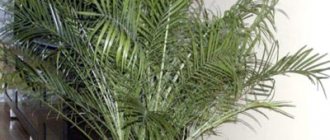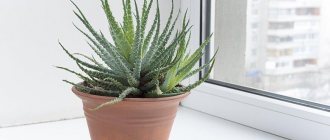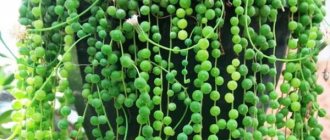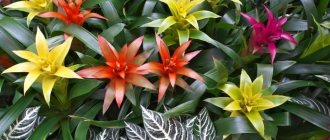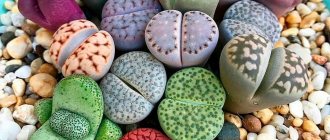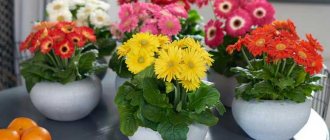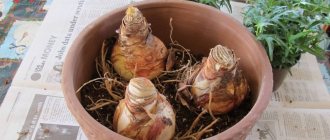Author of the article
Daria Vorontsova
Reading time: 17 minutes
AA
Mangoes are quite easy to grow at home from seeds, the main thing is to follow the rules of care and maintain the necessary conditions. Mango can be kept in an apartment as an unusual ornamental plant. With some effort, you can achieve fruiting and delight your loved ones with fruits with a bright and unusual taste.
Mango in natural environment
In nature, mangoes can reach up to 30 meters in height. In cramped apartment conditions, the plant, as a rule, grows no higher than 2 meters.
Mango has a spherical crown with elongated leathery leaves. The foliage has a pinkish tint when young, which turns dark green over time.
The flowers are small, white or pink, collected in inflorescences up to 40 cm long. The aroma is similar to that of lilies. Flowering occurs from December to April. Fruiting begins from 5-6 years of plant life.
Where to get planting material
Mango reproduces by shoots and seeds. In garden nurseries, seedlings of this tropical plant are not cheap. It is much easier to try to grow it yourself from a seed. To do this, just buy a few mangoes at your nearest store.
When choosing, you should give preference to fruits with elastic skin, without signs of damage or shock. The pulp of a suitable fruit, when pressed, is slightly pressed and quickly restored. Mango should have a fruity aroma without foreign impurities.
If you couldn’t find ripe fruits in the store, you can try to ripen the fruit at home. To do this, wrap it in newspaper and place it in a dark place. As a rule, ripening occurs on days 5-6. You can speed up the process by placing an apple or banana next to the mango.
How to do it?
Don't pay attention to the color: green mango may also be suitable. You need to test the elasticity of the fetus by lightly pressing on it. It should not be hard or deformed. When inspecting the mango, make sure that its skin is unspotted, smooth, and without scratches.
It wouldn't hurt to smell the fruit either. A sweetish smell is a sign of ripeness. But the smell of alcohol should alert you: perhaps fermentation has begun.
- How pomegranate blooms - 115 photos of flowering and rules for growing pomegranate in your own garden. Video instructions for caring for fruit
- How to plant a pineapple from the top: care tips, maintenance rules and features of growing at home (135 photos + video)
- What is the difference between strawberries and wild strawberries - 120 photos, videos and comparison of garden and forest species. Description of differences and detailed analysis of features
Which soil is better to choose?
Any ready-made universal soil with a neutral Ph is suitable for planting. You can purchase special soil for tropical plants.
Helpful information
Daria Vorontsova
Amateur gardener. He is interested in growing various greens at home.
Mango has a two-tiered root system. The top layer is close to the soil surface. The second, in the form of a rod, goes to a depth of 3 meters. Therefore, you should choose a tall pot for planting.
It is necessary to place a drainage cushion at the bottom of the container, at least 5 cm high. Expanded clay, vermiculite, and small crushed stone can be used as drainage.
Mangosteen at home
The exotic fruit is quite difficult to grow at home, but experienced gardeners can try to do it. Seed material is selected and planted in moist, loose soil. The pot is covered with film. Shoots appear in a few days. However, then growth slows down.
Note! Up to 3 years, it is better to shade the plant; after 3 years, it needs open, hot sun.
Sprouts require special care. The plant loves warmth. If the air temperature in the room drops sharply by 7-10 degrees, the bushes will die. High humidity is also important for development. To do this, you need to purchase an air humidifier.
Fruit plants will decorate the apartment and attract the attention of house guests. However, each tree requires its own approach. If you understand all the intricacies of planting and growing exotic plants, you can turn part of your apartment into a green orchard.
Preparing for landing
The easiest way to plant a mango is to bury the seed in the ground and wait for the sprouts to appear. This method has one big drawback. Remaining pulp on the seed can cause rotting and the seed simply will not germinate. To prevent this from happening, preliminary preparation of planting material should be carried out.
The shell of the mango seed is quite dense. It must be carefully opened with a sharp knife. The extracted kernel is soaked in a weak solution of potassium permanganate for 12 hours. After processing, the seed is lightly immersed in a container with slightly damp sawdust. The future plant is placed in a warm and dark place, monitoring the humidity of the sawdust from time to time. After 2-3 weeks, when sprouts appear, you can transplant the plant into the ground.
The extracted bone should not be dried. The longer it is left outdoors, the less likely it is to germinate.
How to plant a mango from a seed
Mangoes will be less hassle if you choose the right planting time. It is best to do this in the summer, since for normal development the plant needs 14-16 hours of daylight, which means that in winter it will require an additional source of lighting. The plant is also demanding of heat: the temperature that suits it is +20...+26°C.
Procedure:
A seed that has just been removed from the fruit is taken (this increases the chances of viable sprouts appearing) and washed under running water. The presence of a crack in the shell allows you to use a knife and without much effort to extract the seed, which resembles a bean. It is placed in a jar of water (the temperature should be room temperature). If the shell is solid, do not try to open it at any cost - there is a risk of damaging the contents. The seed is simply placed in water for a few days, where the shell will become soft and eventually open.
Water with planting material is changed every other day. After 0.5 months or a little later, the mango begins to develop roots, which means it’s time for planting. Before planting, the seed must be treated with some kind of fungicide.
A layer of drainage material is poured into the pot, then soil (the container should be 2/3 full) and watered.
The seed is planted horizontally if it has already sprouted. When there is no sprout, the seed is placed sideways. It is important that ¼ of it remains uncovered with soil.
The soil is watered. Add some soil if it has settled as a result of watering. The pot is covered with film or a mini-greenhouse made from a plastic bottle cut with scissors is installed over the future plant. The shelter can be removed in about 0.5 - 1 month, when sprouts appear.
Landing rules
The hatched seed is planted in a container with soil, leaving 1/4 of the seed above the surface. The seedling is lightly sprinkled with earth and watered generously with warm, settled water.
The pot is covered with film, glass or a plastic bottle and placed in a warm and bright place. Once every 2-3 days, the sprouts need to be ventilated for 5-10 minutes. After the first real castings appear, the ventilation time begins to gradually increase, thereby hardening the plant.
How to grow mango from seed?
Once you have found all the necessary materials for planting, you can begin. We take the seed and begin to peel it from the shell. The easiest way to do this is with a knife. However, you need to be very careful here, since there is a high risk of injury to yourself.
Preparing for sowing
The seed must be separated from the shell, since without it the seed will have an increased chance of successful germination. Peeling the seed is not so easy as it will take time. To grow mangoes at home, you will need a glass with a lid, which will help create conditions that are as close to natural as possible. For mangoes, you definitely need to create high humidity.
After removing the seed from the shell, it must be treated with a pest control agent. Do not underestimate the importance of this operation, since without treatment there is a high probability that pests will not allow the seed to sprout
- Before sowing the seed, you need to determine where the root is and mark this place so that it is located in the recess with its lower part. It should also be borne in mind that when planting, the mango seed is not completely buried;
- It is recommended to plant it in such a way that 1/4 of the seed remains on the surface;
- After planting the seed in the ground, you need to lightly spray it with water, and then close the container with a lid. This way you can maintain greenhouse conditions in the glass, similar to the greenhouse effect;
- the seed should remain covered until it germinates.
Conditions for favorable growth
Mango requires a lot of attention not only during the care process, but also at the planting stage. Otherwise, there is a risk of not waiting for its germination. You also need to be careful after the sprout appears from the seed. Mango is a fastidious crop, so even at this stage of development it needs careful care.
When the mango seedling becomes strong enough, it needs to be transplanted into a larger pot. Moreover, this operation should be carried out every six months. If this is not done on time, the growth of the seedling will stop; it is necessary to take into account that the homeland of mangoes is the tropics, so it must be grown in a lighted place; You also need to be careful about watering: it must be done at least twice a week.
Any delay in watering can negatively affect the development of plants, as a result it may wither; in the summer, in addition to the main activities, you will also have to pay attention to the crown of the plant. We are talking about spraying the leaves, which is carried out several times every day.
The mango itself is valued not only for its tasty pulp, but is also of interest due to the decorative nature of its flowers. It is no less pleasant to watch how the mango grows. Therefore, if you provide the necessary conditions for growth, you will have a beautiful decoration in your apartment.
Common mistakes when planting mangoes
Neglecting planting rules can result in the plant not germinating or quickly dying. The most common mistakes are:
- Incorrect landing . If you bury the entire seed, the sprout will not have enough strength to break through the thick layer of soil. There is also a high probability that the seed will simply rot. If the seed is left on the surface, the seedling will not have enough moisture and will not germinate.
- Watering with cold water . Mango, like all tropical plants, is very sensitive to temperature changes. Low water temperatures can cause the plant to become hypothermic and, as a result, lose its leaves. In addition, improper watering can provoke the development of fungal diseases.
- Using the wrong potty . The container is selected according to the size of the plant. A pot that is too deep provokes the development of the taproot, to the detriment of the above-ground part. The sprout will wither and die. In a container that is too small, the root system will not be able to fully develop.
- Unsuitable environmental conditions . For the first 2-3 months, mangoes are grown in greenhouse conditions. This will protect it from changes in temperature and humidity. The greenhouse is removed gradually after the sprout gets stronger and gets used to environmental conditions.
Planting a seed and getting the first shoots is half the success. In order for the plant to be healthy and pleasing with its appearance, it is necessary to strictly follow the rules of caring for the seedling.
Seedling care
Like all tropical plants, mangoes need to be created in conditions close to their natural habitat. An important condition is maintaining optimal temperatures, humidity and daylight hours.
Temperature and lighting
It is best to place a container with a strong and grown sprout on the sunny side of the apartment. The light falling on the plants should be diffused. It is important to avoid direct sunlight, as this can lead to sunburn.
The best time to plant mangoes is in late spring. Over the summer, the plant will receive enough heat and light and will be able to properly grow stronger. In winter, the sprout must be illuminated with phytolamps. Daylight hours should be at least 14 hours.
The optimal ambient temperature is considered to be 24-27°C. In hot weather, the plant can be taken outside or onto the balcony, placing the pot away from drafts.
Humidity and watering
Mangoes require a lot of moisture to function properly. Water the plant at least once every three days. Warm, settled water is used for irrigation. At the same time, it is important to monitor the condition of the soil. Excess moisture is also harmful to mangoes; it can cause root rot and plant death.
You can place the pot with the plant in a deep tray with warm water. This will eliminate the need to control soil moisture, while at the same time the plant will receive all the necessary nutrients.
Top dressing
Feed mangoes every 2-3 weeks. As fertilizers, organic matter, nitrogen-containing preparations and vermicompost are alternated (vermicompost can be replaced with potassium humate or Epin solution). Mango grows well on ready-made complexes for citrus and palm trees.
As a source of nitrogen you can use:
- 2% urea solution;
- ammonium nitrate;
- ammonium sulfate.
Organic fertilizer can be prepared at home. To do this, fill a five-liter plastic container ⅔ full with finely chopped nettles and add a handful of manure. The container is filled with water and left in a warm place for 5-7 days. The solution will be ready when the fermentation process noticeably decreases. Before use, the solution is diluted with water in a ratio of 1:10. Such feeding is carried out in the summer.
Twice a year the plant is fed with humus. A groove is made in the soil along the edge of the container and filled with fertilizer. Sprinkle soil on top and lightly moisten.
Once every 3 months, mango foliage is sprayed with a solution of copper sulfate or boric acid.
Transfer
Mangoes do not respond well to transplantation. This causes stress on the plant, which may cause it to drop its leaves.
It is recommended to change the container no earlier than after a year, when the tree has grown and become stronger. Transplantation is carried out using the transshipment method. To do this, water the plant abundantly and leave for half an hour to soften the soil.
A drainage pad is placed in a new pot and lightly sprinkled with soil. The container with the plant is carefully turned over and the tree is removed along with the earthen lump. Transplant into a new container and fill the voids with soil. The soil is well moistened. The tree is placed in a shaded place for the adaptation period.
Trimming
Mango has an extensive dense crown that needs to be monitored. The first pruning is carried out when the plant height is 1.5 meters. In the future, to regulate the plant and maintain a neat shape, the crown is cut 2 times a year.
Helpful information
Daria Vorontsova
Amateur gardener. He is interested in growing various greens at home.
To form a beautiful and even crown, it is recommended to rotate the pot relative to the light source from time to time.
During pruning, remove all weak and dry branches. Thin out places where foliage thickens. The crown can be formed in the form of different shapes: a ball, a pyramid or a spreading bush.
To prevent the tree from growing too much upward, during pruning the crown is pinched 3-5 cm. The cut areas are treated with garden varnish or an antiseptic.
Growing kiwi
Kiwi will become a real pride of the gardener. This is a powerful vine that grows without problems in an apartment. The only problem is to find a mate for the plant so that it can flower and bear fruit. There is nothing complicated about planting and growing vines. Seed germination is almost 100%.
Recommendations for growing:
- Planting material is the seeds of ripe fruit.
- They are carefully cleaned from the pulp. Next, wrap it in a cloth and wash it under the tap.
- The seed is placed on wet gauze, covered with a glass bowl and placed on the windowsill. The gauze is periodically moistened.
- After a week, each seed will sprout.
- Neutral soil is suitable for planting. It is best to take nutritious soil for lemon.
- The seeds are planted shallowly in the ground, watered with water and covered with cling film to create a greenhouse effect.
- Picking takes place a month after planting. Each specimen is placed in a separate pot. Kiwi has large leaves; if the plants are planted in the same container, they will shade each other.
Kiwi in the apartment - You should start growing kiwi at home by choosing the right place. The place should be bright and warm. You can install fluorescent lamps above the exotic.
- Feed the vine several times a year. Compost is added to the pot.
Additional Information. Another important point in care is pinching the top of the vine. This move will stimulate the development of foliage from the sides.
Diseases and pests of mango
Mangoes have no specific diseases. Signs of the disease and treatment are the same as for other indoor plants. The reason for their appearance may be errors in care or proximity to already infected plants.
Mango diseases
Powdery mildew appears due to excess humidity in the air or soil. Signs of the disease are a white coating on the leaves, thickening and deformation of the shoots.
For treatment, the plant is treated with a solution:
- Toxina-M;
- Topaz;
- Thiovit-Jeta;
- Bayleton;
- Fundazola.
Treatment is carried out 3 times with an interval of 7 days. It is recommended to alternate medications.
As a preventative measure, it is recommended to spray the plant with the following solution:
- Planriza;
- Alirina;
- Fitosporina.
Irrigation with an infusion of wood ash helps well in the fight against powdery mildew.
Bacteriosis can occur due to infection through damage to the trunk and leaves. Another cause of the disease is excess fertilizer. Signs of bacteriosis are dark soft spots on the trunk and leaves with a strong smell of rot.
The treatment is complex and is carried out in several stages:
- Damaged areas are cut off, capturing 5-7 cm of healthy tissue.
- The cut areas are treated with a 2% solution of copper sulfate.
- Completely change the soil in the pot.
- Alirin-B and Trichodermin are added to the soil.
- The plant is sprayed with Bordeaux mixture.
- For a month, the plant is watered with a weak solution of potassium permanganate.
Anthracnose appears as brown or yellow spots on the leaves. This is a fungal disease caused by infection through damage to the leaves and trunk of the plant.
As a treatment, the affected areas are trimmed. The plant is thoroughly washed under a warm shower and transplanted into new soil. It is recommended to treat the wood with a solution:
- Fitosporina;
- Cuprosan;
- Oxychoma;
- Akrobata-MC.
Treatment is carried out 3 times with an interval of 14 days. It is recommended to alternate spraying preparations.
To prevent the disease, you can use the drugs Fitosporin-M, Gamair and Trichodermin. Many gardeners dust the soil and plant with crushed activated carbon or chalk.
Pests
The most common pests that can be found on home-grown mangoes are spider mites and thrips. Both feed on plant sap and are classified as sucking pests.
Spider mite
Thrips
The appearance of a spider mite can be suspected by the appearance of a thin web on the underside of the leaves. The appearance of thrips is indicated by sticky brown spots on the inside of the leaves and silvery marks on the outside.
To combat pests, the plant is thoroughly washed with soapy water. Areas with signs of damage are cut off. The seedling is treated with the following preparations:
- Akarin;
- Apollo;
- Kleschevitis;
- Neoron;
- Fitoverm
- Vertimek.
Spraying is carried out 3 times with an interval of 10 days.
Helpful information
Daria Vorontsova
Amateur gardener. He is interested in growing various greens at home.
During the fight against the emerging pest, the infected plant must be quarantined, moving it away from other plants. Preparations are used to treat not only the tree, but also the place where it was located.
Another common pest on indoor plants is scale insects. This small insect with a hard shell feeds on plant sap. The appearance of scale insects can be detected by characteristic brown plaques on the trunk and leaves of plants.
Thanks to its shell, the scale insect is reliably protected from external influences. Therefore, when this pest is detected, there is no point in grabbing drugs. First, insects should be removed mechanically. To do this, the plant is thoroughly wiped with a soft cloth and soapy water. After treatment, wash the seedling under a warm shower.
After most of the insects have been removed, insecticides are used. They destroy eggs and larvae of pests invisible to the eye. In addition, the preparations create a thin film on the surface of the leaf, making it inedible for pests. You can use the following against scale insects:
- Aktellik;
- Fufanon;
- Phosbecide.
Treatment is carried out 3 times with an interval of 2 weeks.
To prevent the appearance of scale insects, you can spray the plants once a month with an infusion of onion peels or garlic.
Together with poorly disinfected soil, aphids can get onto the plant. Colonies of these sucking insects can be easily seen on the undersides of leaves.
When aphids appear, mangoes are sprayed 2 times with an interval of 2-3 days with a soap solution or infusion of ash. If treatment does not help, you can use the following medications:
- Inta-Vir;
- Iskra-Bio;
- Confidor-Maxi;
- Mospilan.
For prevention, you can spray the plant with an infusion of herbs with a pungent odor: garlic, wormwood, lavender, onion or tobacco.
